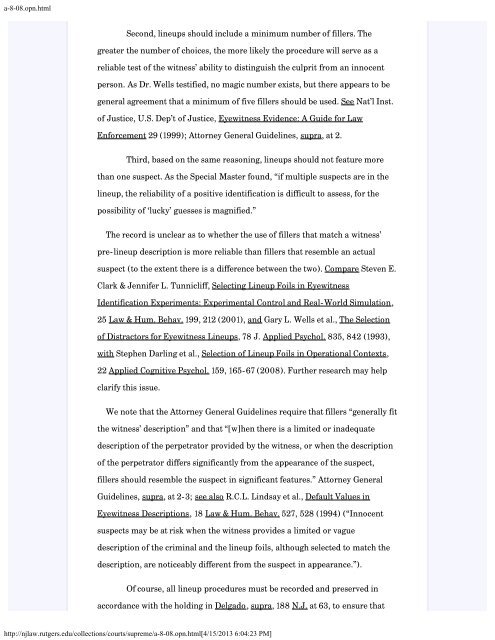State v. Henderson and the New Model Jury Charges - New Jersey ...
State v. Henderson and the New Model Jury Charges - New Jersey ...
State v. Henderson and the New Model Jury Charges - New Jersey ...
Create successful ePaper yourself
Turn your PDF publications into a flip-book with our unique Google optimized e-Paper software.
a-8-08.opn.html<br />
Second, lineups should include a minimum number of fillers. The<br />
greater <strong>the</strong> number of choices, <strong>the</strong> more likely <strong>the</strong> procedure will serve as a<br />
reliable test of <strong>the</strong> witness’ ability to distinguish <strong>the</strong> culprit from an innocent<br />
person. As Dr. Wells testified, no magic number exists, but <strong>the</strong>re appears to be<br />
general agreement that a minimum of five fillers should be used. See Nat’l Inst.<br />
of Justice, U.S. Dep’t of Justice, Eyewitness Evidence: A Guide for Law<br />
Enforcement 29 (1999); Attorney General Guidelines, supra, at 2.<br />
Third, based on <strong>the</strong> same reasoning, lineups should not feature more<br />
than one suspect. As <strong>the</strong> Special Master found, “if multiple suspects are in <strong>the</strong><br />
lineup, <strong>the</strong> reliability of a positive identification is difficult to assess, for <strong>the</strong><br />
possibility of ‘lucky’ guesses is magnified.”<br />
The record is unclear as to whe<strong>the</strong>r <strong>the</strong> use of fillers that match a witness’<br />
pre-lineup description is more reliable than fillers that resemble an actual<br />
suspect (to <strong>the</strong> extent <strong>the</strong>re is a difference between <strong>the</strong> two). Compare Steven E.<br />
Clark & Jennifer L. Tunnicliff, Selecting Lineup Foils in Eyewitness<br />
Identification Experiments: Experimental Control <strong>and</strong> Real-World Simulation,<br />
25 Law & Hum. Behav. 199, 212 (2001), <strong>and</strong> Gary L. Wells et al., The Selection<br />
of Distractors for Eyewitness Lineups, 78 J. Applied Psychol. 835, 842 (1993),<br />
with Stephen Darling et al., Selection of Lineup Foils in Operational Contexts,<br />
22 Applied Cognitive Psychol. 159, 165-67 (2008). Fur<strong>the</strong>r research may help<br />
clarify this issue.<br />
We note that <strong>the</strong> Attorney General Guidelines require that fillers “generally fit<br />
<strong>the</strong> witness’ description” <strong>and</strong> that “[w]hen <strong>the</strong>re is a limited or inadequate<br />
description of <strong>the</strong> perpetrator provided by <strong>the</strong> witness, or when <strong>the</strong> description<br />
of <strong>the</strong> perpetrator differs significantly from <strong>the</strong> appearance of <strong>the</strong> suspect,<br />
fillers should resemble <strong>the</strong> suspect in significant features.” Attorney General<br />
Guidelines, supra, at 2-3; see also R.C.L. Lindsay et al., Default Values in<br />
Eyewitness Descriptions, 18 Law & Hum. Behav. 527, 528 (1994) (“Innocent<br />
suspects may be at risk when <strong>the</strong> witness provides a limited or vague<br />
description of <strong>the</strong> criminal <strong>and</strong> <strong>the</strong> lineup foils, although selected to match <strong>the</strong><br />
description, are noticeably different from <strong>the</strong> suspect in appearance.”).<br />
Of course, all lineup procedures must be recorded <strong>and</strong> preserved in<br />
accordance with <strong>the</strong> holding in Delgado, supra, 188 N.J. at 63, to ensure that<br />
http://njlaw.rutgers.edu/collections/courts/supreme/a-8-08.opn.html[4/15/2013 6:04:23 PM]
















